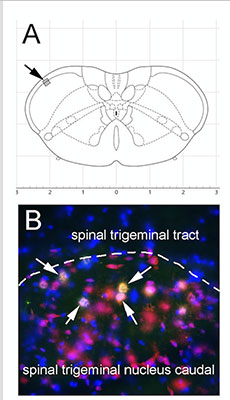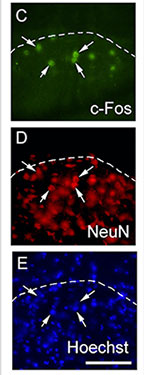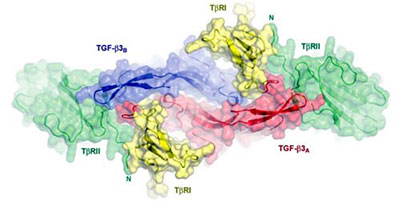Major Areas of Research
Developmental biology and genetics of craniofacial tissues
-
Craniofacial patterning
-
Morphogenesis and stem cell-mediated tissue engineering
-
Regenerative medicine
Craniofacial birth defects, including cleft lip and palate, craniosynotosis, tooth agenesis and other syndromes involving the facial structures, occur in approximately 1 per 500 live births in the United States.
Our investigators are studying the role of genes and proteins, including the signaling molecules involved in palate, cranial sutures, tooth and bone development; genetic etiology of tooth agenesis; molecular control of odontoblast differentiation, and the use of tooth-derived stem cells for the regeneration of the dentin-pulp complex.
Laboratories
Temporomandibular joint (TMJ) development and response to pain

 TMJ disorders are reported more frequently in females than in males, implying that the different concentrations and patterns of sex hormones are a potential cause for this observed gender disparity. The aim of the studies is to provide new targets for drugs that would be efficacious in treating female patients with TMJ disorders involving inflammation.
TMJ disorders are reported more frequently in females than in males, implying that the different concentrations and patterns of sex hormones are a potential cause for this observed gender disparity. The aim of the studies is to provide new targets for drugs that would be efficacious in treating female patients with TMJ disorders involving inflammation.
Studies are being conducted in the areas of hormonal influence on pain and inflammation in the TMJ and feeding behavior as a model for studying TMJ pain. The research focuses on the development and regulation of the inflammatory responses, particularly crosstalk between the nervous and immune systems; identification of potential targets for therapeutic intervention in the treatment of inflammation and pain; characterization of age, gender and ethnic differences in the pathogenesis of acute and chronic inflammation; elucidation of signal transduction mechanisms during inflammatory joint diseases.
Another research group is concentrating on the unique structural and growth properties of the TMJ cartilage; influence of growth hormone on the growth of the craniofacial skeleton; interaction of growth hormone and mandibular posture in the regulation of condylar cartilage proliferation and mandibular growth.
The figure shows the following:
(A) Fluorescent staining for ERα (red) and Gabrα6 (green) indicated that a few cells contain both ERα and Gabrα6 (yellow arrows); representative image of three proestrus rats. Cell nuclei are stained blue with Hoeschst dye.
(B) No fluorescent signal was observed with the addition of primary antibodies. Bar = 20 μM
Laboratories
- Kramer/Umorin (Influence of sex hormones on TMJ pain &inflammation)
- Tao, S.Liu (Mechanisms underlying oralfacial pain including TMJ Pain)
Mineralized tissue biology, bioengineering and regeneration
Mutations in a protein expressed in bones and teeth, dentin matrix protein 1 (DMP1), cause hypophosphatemic rickets. This discovery led to a current research project examining the function of this protein in normal and abnormal conditions through different animal models. Another project examines the causes of osteoarthritis, a common disease that affects 60% of the aging population, by generating mice that lack a potent growth factor, GEP. These animals develop severe defects in early cartilage development and display signs of osteoarthritis. Studies using this animal model may provide us with naturally-occurring novel therapeutics for the treatment of arthritic diseases.
Other ongoing studies at the dental school are examining the structural properties, biomechanics and modeling of the craniofacial skeleton, specifically to understand the mechanical and elastic properties of craniofacial bone; the evolution of craniofacial form in humans and other primates; the use of digital imaging and biostatistics to illuminate the growth and development of the facial skeleton, particularly in cleft patients.
Knowledge about the structural biology and biomechanics of dental tissues, particularly dentin and bone, can be applied to the design of new dental materials, bioengineered scaffolds, and delivery vehicles needed for tissue regeneration. Projects in this area of study include the testing of novel scaffolds that are conducive for the vascularization and regeneration of dentin and bone matrices.

